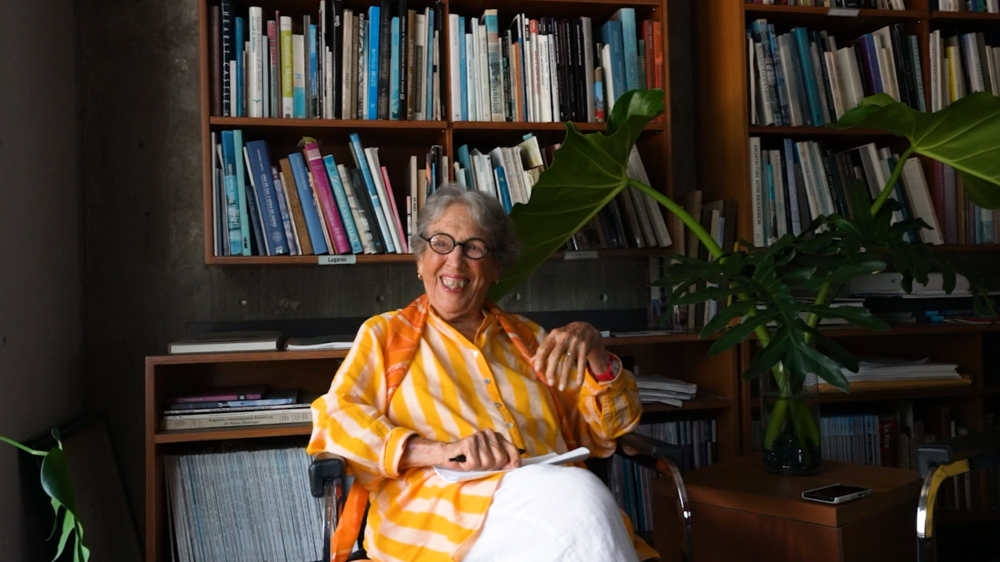Questions For a Designer: Lucilla Fuller Marvel
And her legacy in Puerto Rico as a teacher, author, social and urban planner.
Lucilla Fuller Marvel's career is a testament to her diverse talents as a teacher, author, and social and urban planner. As a former educator at the University of Puerto Rico, she emphasized participatory planning, reflected in her influential work "A Guide for Municipal Planning in Puerto Rico." Other authored works, including "Listen to What They Say: Planning and Community Development in Puerto Rico " and "Planning for a Sustainable Puerto Rico: Fundamentals of the Process," showcase her deep understanding of community-centric planning. Her leadership within the Puerto Rican Planning Society and extensive consultancy work highlight her dedication to social justice and equitable development. Notably, her unwavering commitment to community engagement has left a lasting imprint on her son's architecture practice, Marvel. In honor of Women’s History Month, we sat down with Lucilla to learn about her inspiring journey and her impactful contributions to design and social change, as well as her chance meeting with her husband, Thomas S. Marvel.
The following conversation has been edited for length and comprehension:
Could you introduce yourself for anybody who doesn’t know about you or your body of work?
My name is Lucilla Fuller Marvel. I studied architecture at an undergraduate level, then I graduated, and we moved to Puerto Rico in 1959, my husband and I. We were 23 and 24 years old, with a three-month-old son, and we've been here ever since. And it's been really a fascinating, very rewarding, and rich life- blessed with many opportunities. I pursued a master's degree from the University of Puerto Rico's Graduate School of Planning, and it happened to be a terrific planning program at that time. On the cutting edge, radical, little left, progressive–it was a very good education. I graduated and started teaching right away. But I was still working, very involved, hands on the ground, while I continued teaching. I had the fortune to understand that where architecture and planning cross is the urban context, generally. It is a space where very few people are trained and have the sensitivity, the education, or the appreciation of how so much comes together.
Of course I defined my work as I got older, but at the time I wasn’t really aware of what I was doing. I wasn’t doing architecture- definitely planning- but I always knew I worked in space. And so while I taught, I was able to introduce some new courses at the Graduate School of Planning, where most other planners were assembling documents and making plans, but not dealing with space. Architects on the other hand were working with buildings that would fill space, in volumes. But nobody was bringing together space, place, and people.
Planning is a very synergetic field- and one thing that it does, even on paper, is that it brings together everything. You have to look at the whole before you start looking at any one particular piece, place, or group. So, here I am still.
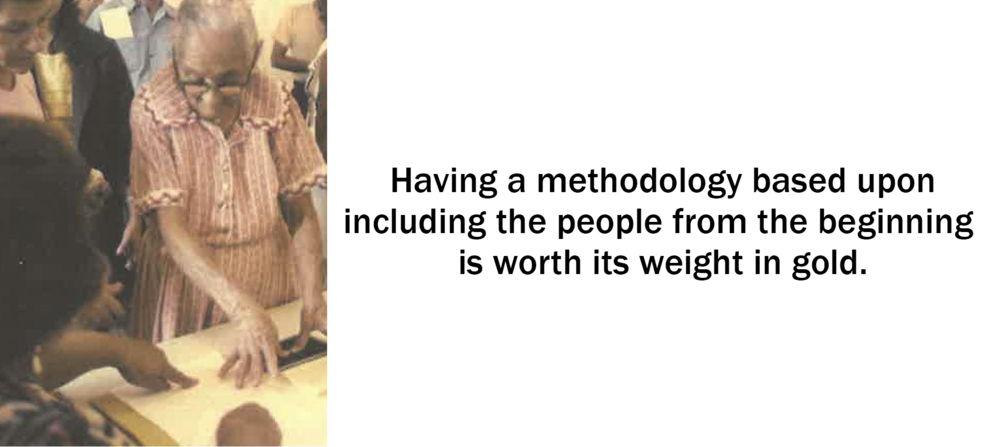 Left: Mameyes survivors at a ceremony to sign property titles for houses in New Mameyes, June 1986. Photo by Lucilla Fuller Marvel.
Left: Mameyes survivors at a ceremony to sign property titles for houses in New Mameyes, June 1986. Photo by Lucilla Fuller Marvel.
How did you meet your husband?
I had a degree in what's called architectural sciences, which was Harvard's undergraduate program for would-be architects. But I did finish the first year of the Harvard Graduate School of Design, and I sat two desks behind Tom Marvel, and the rest is history.
A school love story. How did that go?
How did that go? Well, it was wonderful. Of course it wasn’t the shared class time. It was the shared work time. As we all know, you’d stay up and have all-nighters, and you’d spill a bottle of ink at midnight. I’d say, “Oh, how am I going to take care of that?” And who would come to my rescue but Tom Marvel?
He was very special and highly talented. I think that we were very fortunate to work together. His office did a lot of planning work, master planning, urban planning. He was, by nature, an intellect, a planner, he trained as an architect at Harvard. He could bring all the different themes together under a synergetic umbrella. In all of the planning work that was done, I was contracted to do the social. Planning was always interdisciplinary, with teams of social, economic, physical, environmental, and regional experts.
So we started doing master plans for some of the very old towns of Puerto Rico. We did master plans for Bayamón, a city just to the west of San Juan, and then Río Piedras, a former town and current district in San Juan. In Puerto Rico, the cities all reached their peak in about the 1950s. Then with an increase of migration, there was an economic downturn, and consequently deterioration of physical buildings and space. People were moving out. Urban sprawl was taking over. It’s been fascinating and disheartening to witness.
Anyway, I worked in the office with a lot of master plans. And I studied the people. I would often get asked questions, “What do you do Lucilla, with your planning degree?” So, I learned to say, “Well, I deal with people.”
How has the world of planning changed in all the years that you've been here?
It turns out that just because I’ve lived long enough, I’m now considered a pioneer in participatory planning. One way the world of planning has changed, as the world has changed, is that the people who are the subject of planning exercises are now involved from day one. That’s something I used to have to fight for.
In 1985 I was in charge of one project relocating the survivors of a hillside community in Ponce called Mameyes. Mameyes had been self- built on sliding limestone, and after 24 hours of 21-inch rainfall, the community just tumbled down the hill. To this day, it is still the largest number of lives lost on U.S. soil in a single landslide. The question became, “What are we going to do with the survivors?” The head of the Puerto Rico Department of Housing said, “Send Lucilla to Ponce; she deals with people.”
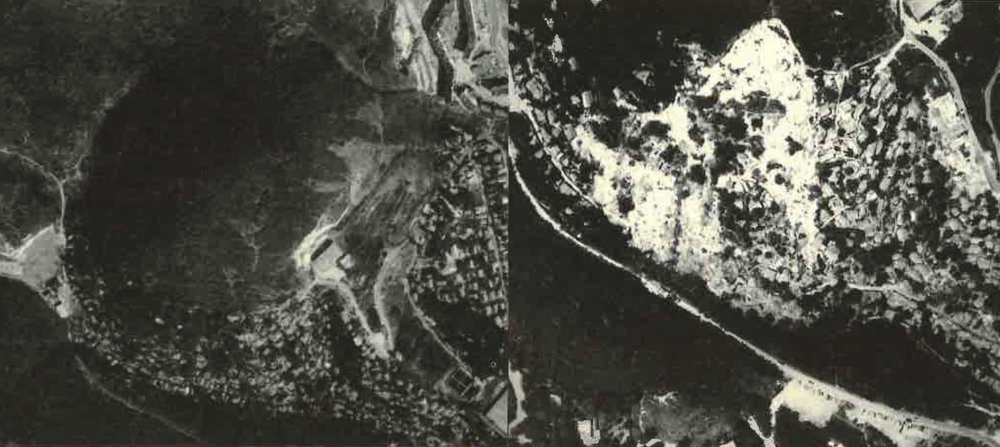 Left: Before the disaster, Mameyes, Ponce, 1983. Right: After the disaster, 1985. Photos: Dept. of Transportation and Public Works, San Juan.
Left: Before the disaster, Mameyes, Ponce, 1983. Right: After the disaster, 1985. Photos: Dept. of Transportation and Public Works, San Juan.So I went and I worked with this community for a long time, and you can imagine working with people who had lost their relatives, their homes, and had no place to go. They became the spokespeople for what they wanted. Their community was self-built: the people built and owned their houses on someone else’s land- which many in the United States call a squatter community. I don't usually use the word squatter, and I definitely don't use the word slum, but it’s a worldwide issue today, and Puerto Rico has been at the forefront looking for solutions that respect the dignity of these communities.
I would bring the community members to meetings with the heads of government agencies to discuss the fate of Mameyes survivors, and they’d say, “the people can wait outside until we finish the meeting. You can tell them what we talked about after.”
And I said, “They’re joining this meeting. They know what their needs are, this is where they live. If you don’t include them in this process, then they are treated as second-class citizens.”
I was very fortunate that from 1985, and even earlier, I always brought the people into the process from day one. Facilitating the conversation, teaching them to be planners and spokespeople for their future lives. Since then, Puerto Rico has been very strong on this. And after Hurricane Maria in 2017, who were the first responders? Not the government agencies, but the community leaders. That’s a huge change, to answer your question. You don’t want to design a building in absence, in a vacuum. You want to design it with the people.
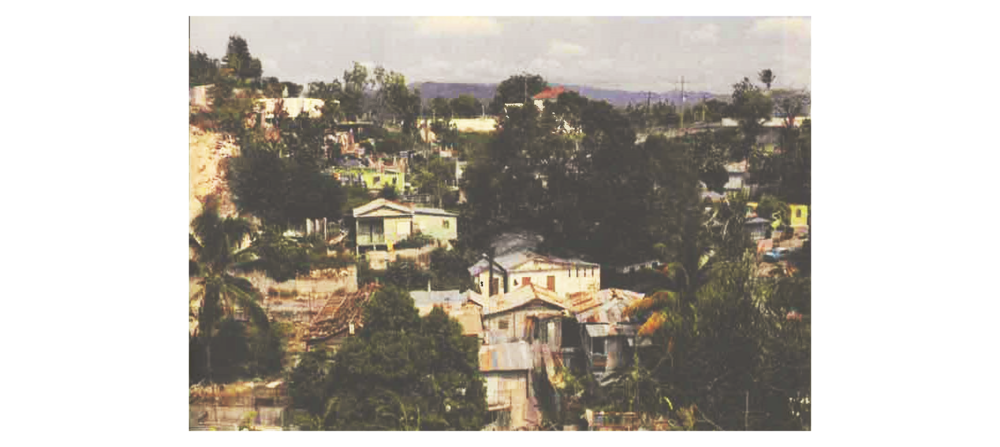 Edge of disaster area. Photo by Lucilla Fuller Marvel.
Edge of disaster area. Photo by Lucilla Fuller Marvel.
Do you think this change influenced Marvel as a firm as well?
Oh, absolutely. I've seen presentations of six people from the Marvel office within the past year at the Colegio de Arquitectos here. I was very interested listening to the six architects. Some got right to it, “We talk to the people first. We have little survey forms. We sit down and meet with them. We draw. We do all kinds of things.”
And so the clients or users are part of the process. They're part of the territory from the beginning. But other architects do the thinking and then go to the people. You've got to go to the people first. It makes a huge difference. It may cost a little more, it may take a little more time, but they're part of it. And in the end, having a methodology which is based upon including the people from the beginning is worth its weight in gold. You're not redesigning a community and building a 20-story building in Brooklyn for yourself. You're doing it for somebody else. Well, who are the somebody elses? And who are their neighbors? It's a community. One house doesn't make a neighborhood.
Did this change happen before or after you published Listen to What They Say?
Oh, no. I wrote ‘Listen to What They Say’ based upon my experiences. I realized my experiences were quite extraordinary. Extraordinary opportunities to work with people. As an example, to be able to go to a meeting at a good university that was doing a plan for a sector of San Juan that needed a great deal of help- terrible unemployment, buildings falling down, lack of education, growing homeless population. The university group said, “let’s invite Lucilla. She’s got a whole process for this.”
So I went, and I said, “Well, where's so-and-so from the community?” the reply: “ Oh, we're going to get the plan together, and then we're going to consult with the community.” Now, I'm talking about 1994, 1995. That would not happen today. The community leaders would get wind of it. They would ask to be a part of it, and they would protest because the tip down is still unfortunately happening.
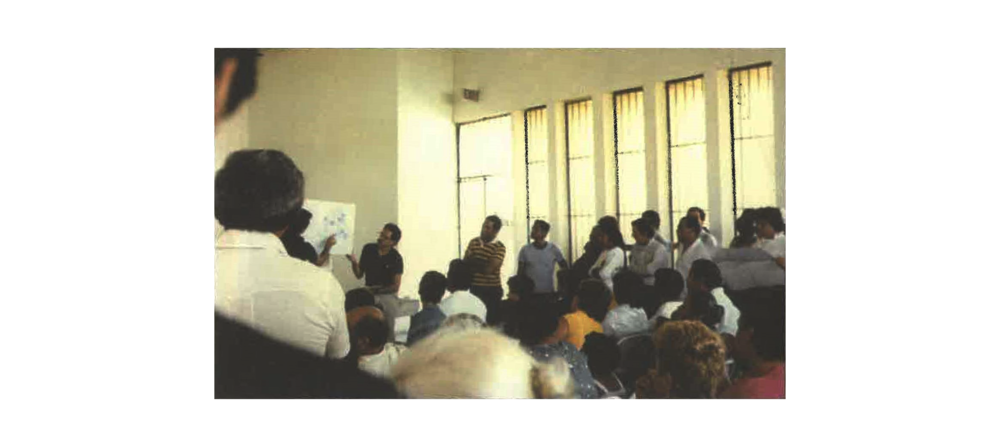 Meeting of Mameyes survivors, December 1985. Photo by Lucilla Fuller Marvel.
Meeting of Mameyes survivors, December 1985. Photo by Lucilla Fuller Marvel.We have a very exciting project in Puerto Rico. It's called El Proyecto ENLACE del Caño Martín Peña, and it's for an area right here in the center of the city. There is a large population of about 18,000 people, 8,000 houses. A lot of squatter housing, houses built on public land that didn’t belong to the people. There’s a channel waterway going through it and the area’s floodable and contaminated, so who and what will plan for improvements? The Chamber of Commerce proposed, for instance: “we’re going to knock it all down and build very attractive high-rises on this land” The government however led the planning for the area and the people have participated in this huge on-site redevelopment planning process. More than 700 community meetings were held over a three-year period to prepare a comprehensive rehabilitation plan.
Anyway, the reason I mention this project is because it’s the first urban squatter community in the world where the land title was placed into a community land trust. The people still own their houses, but the land trust owns the land. The occupation of the land was legalized, displacement was minimized and the project won a UNESCO award in Quito, Ecuador in 2018. It's a very important project. I'd say it's Puerto Rico's largest comprehensive participatory planning project, and it’s right here in San Juan.
Do you have any advice for young aspiring women in design? What would you want to hear if you were just starting your career in architecture?
When I was a student at the planning school, I almost gave it up because at one point I think I wasn't able to manage the laundry one week, or something like that. I went and spoke to the school secretary, and I said, “I'm making too big a sacrifice. I can't take care of the children, the family, my husband, the food, and study. I need to withdraw. ” She said, “Sacrifice, Lucilla? You're making a sacrifice? Talk to me about sacrifice.”
Compared to people who do sacrifice, I mean, really sacrifice, a lot of it depends on your whole value system and what your vision is of what you want the world to be. So I guess my one recommendation for young women is to seek balance. What is your overall value system? Most people who go into planning as students and are just starting to do work, do have a value system based on human rights. When I was a student , the Universal Declaration of Human Rights was fairly new . Today we’re finally hearing more about rights; people are talking about rights and planning and designing accordingly, and saying, well look, there's 17 goals in this area from the United Nations Declaration of Human Rights. So how do you live a life respecting that, while leading your own life as a student, as a young professional, raising a family and other obligations? Very difficult, and while I do understand that it's difficult, don't give up!
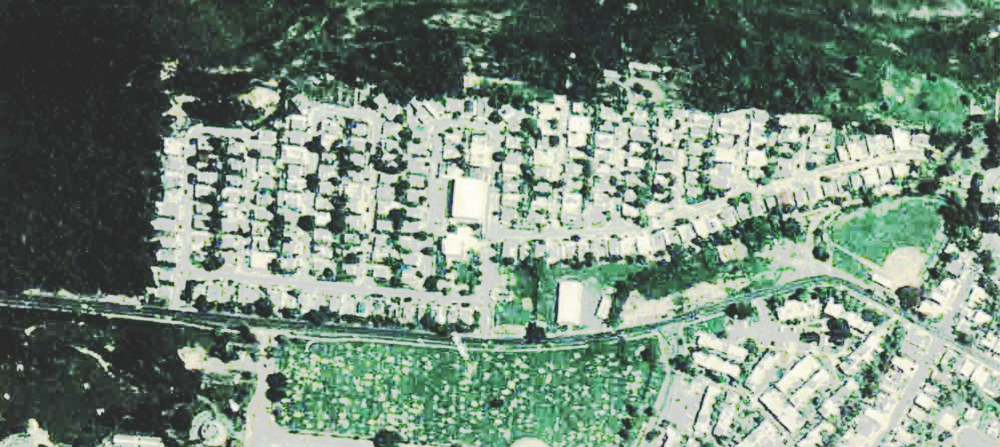 New Mameyes, 2001. Photo: Dept. of Transportation and Public Works, San Juan.
New Mameyes, 2001. Photo: Dept. of Transportation and Public Works, San Juan.
You detailed a great story of yours from your days in planning school in your book, where you were given 25 cents. Could you tell us about it?
Well, as I mentioned, the education at the School of Planning was very good. One course was the theory of social action in small groups, where the professor believed that you have to be active and involved with the people with whom you're planning. You have to understand all contexts of life, and having power and not having power.
So his weekend assignment was to drop each student off at a particular corner in one of the squatter self-built communities of San Juan We were dropped off individually at a street corner on a Friday afternoon at four o'clock . And he said, I'll be back to check on you Saturday. You have 25 cents in your pocket, and if anything goes awry, call me. Your assignment will be finished Sunday afternoon.
I think I wore a dress, not jeans, and carried a little bag, not a knapsack. I went around and I said, “Hello, I'm a student in the School of Planning, and the professor has asked the students to spend a weekend in different communities, and he's dropped me off here in Figueroa. I'm looking for a place to stay for the next two nights and I don’t have any money to pay for this.”
I walked around and around but nobody had any idea where I could go. They all thought I was an agent for the CIA or the gun control bureau or something like that. I spoke Spanish, but I think my accent's a lot better now than it was when I first arrived.
Finally someone said, “Send her down the street to Coco's house.”
I went to Coco's house, and it was a wooden house she lived in with her two twin sons and an older son named Junior. I slept in a little room that was out in the back of the house. It was right in the middle of the city, an old wooden dwelling attached to the main house. The bathroom was also outside in a privy. By 7 o'clock that night, Coco was cooking dinner, rice and two pork chops, food she had on hand. I learned that a lot of rice and two pork chops can go very far. People kept dropping in to see who was Coco's guest. They'd heard about me, right? I closed the door at night with a little hook, and I could hear the coquís as well. I thought, this is it. This is wonderful. I was very grateful to Coco for taking me in.
The next day I learned that she had a boyfriend, but couldn't spend a lot of time with him because it was Saturday, and she had to take care of the kids. I said, “Coco, well, I'll take care of your kids for today, and you can go off with your boyfriend and have a nice time.”
She said okay, and she told her boyfriend, “This is the lady who's staying with me. She doesn't have any money, and she needs a place to stay, and that's why I'm letting her stay here, and I'm feeding her.” And that night, she decided I should stay inside the house, so I slept on a couch inside. It was hot and filled with mosquitoes, but nevertheless, it was fine.
So, I walked around the community with the boys. Now, this was the most important part of this story. You could see that everybody had some little thing they were doing to make an extra penny. And a lot of people sold either ice cream or sorbet that they made. For instance, one woman had a little candy store that she opened in her garage. I had all three boys with me and as we walked by I said, “would you like some candy?”
It was five-cent candy. And they said, “Well, we don’t have any money.”
I told them about the 25 cents in my pocket. Junior, the oldest of the three, looked at me and said, “You lied to us. You told us you didn’t have any money, that’s why we had to find a place for you to stay. You lied to us.”
Transformative experience, because from that time on, working with the communities who were lied to, left and right, through the ages, by the power structure, I learned to always tell the truth. It was a fascinating weekend. Some of my classmates gave up. They told the professor: “I can't take it, found it too tough”.
In my book, you'll see there's a mention of my experience. I asked Junior, at one point, to draw a picture of their house. The picture that Junior drew is in the book.
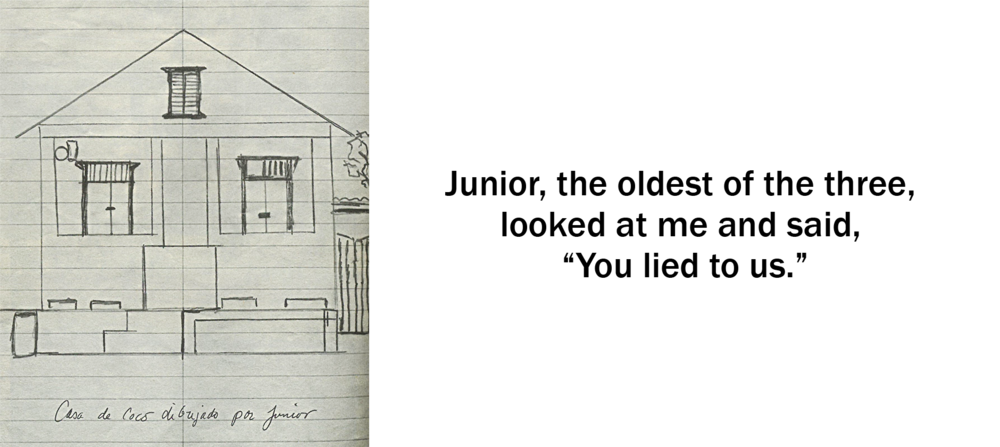 Left: Coco's house drawn by her son, Junior. Barriada Figueroa, San Juan, 1971.
Left: Coco's house drawn by her son, Junior. Barriada Figueroa, San Juan, 1971.
Did you ever stay in touch with Coco? How did that experience affect you?
I went back a couple of times, but that was it. I've become very good friends with some of the community leaders. When I talk about women who've been influential in my life, I have my good friends and family, but I also include community leaders. And I think of one, Mabel from Cantera. I refer to her as the eyes and ears of the Cantera people. She’s a remarkable woman. So bright, intelligent, and articulate. Many of the community leaders are women. Often women headed households.
In my experience working in Mameyes, I worked with FEMA to determine eligibility, who had lived in the community and who would get a new house, and who was going to get priority for the new houses. I shared everything I learned from FEMA with the people, and that allowed certain decisions to be made, such as the priorities to be determined. But I never lied to the people.
There was one man who fought until the very end to prove that he lived in Mameyes. He said his house was destroyed and that this was the truth. But the community group said, “Lucilla, he did not live here, you have to make sure he doesn’t get a house.” It was a two-way process.
I had to make sure the government understood that information. Don’t lie to the people, tell them what you know, it’s their lives. That’s what I learned from Junior.
As you look back on your career, do you find yourself reflecting on the significant impact you've made on urban development and community well-being in Puerto Rico?
I was thinking of a fantastic professor of community social work that I worked with. One afternoon in a community redevelopment project, we were sitting in a baseball field and the residents were sitting in the bleachers and we were leading the meeting at 4 o’clock on a beautiful holiday afternoon. We looked at each other and said, “Don't you just love this? Sitting here listening, what the people have to say about what they want in life, what their needs are, what they can do, and what we can do.”
So being in a position to help them is really what it boils down to. I've been so fortunate and I've loved every minute of it. I've been blessed with still being here and seeing the evolution of a lot. Both Marvel and Jonathan have definitely been shaped by where he was born. Tom and I certainly shared the same value system. We were able to believe in what we did and believe that we had added value to Puerto Rico. And to be accepted by the people here, it’s really a tremendous privilege.
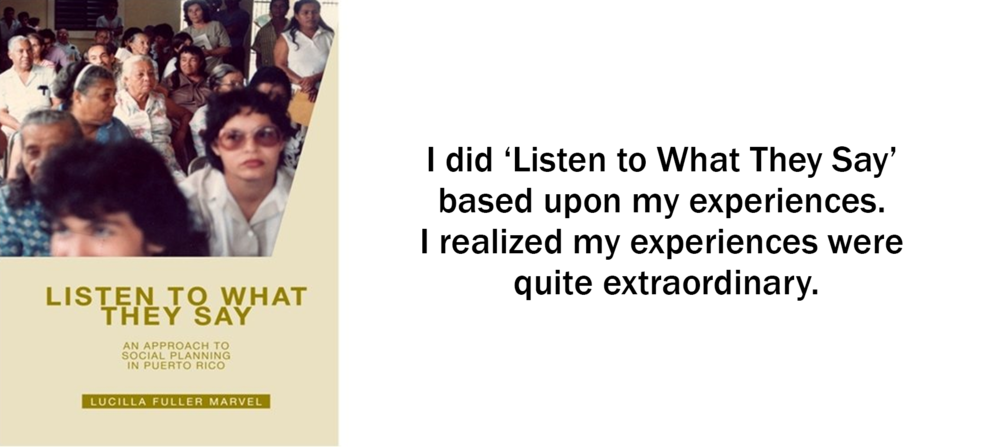 Left: Listen To What They Say by Lucilla Fuller Marvel, 2008.
Left: Listen To What They Say by Lucilla Fuller Marvel, 2008.
Lucilla Fuller Marvel's journey epitomizes a lifelong dedication to reshaping urban landscapes and fostering community empowerment. From her formative years as an educator at the University of Puerto Rico to her pioneering work in participatory planning, Lucilla's impact reverberates across generations and disciplines. Her commitment to inclusivity, social justice, and equitable development has not only transformed the field of urban planning but has also inspired a new generation of architects and planners, including those at Marvel. As we reflect on her remarkable career during Women's History Month, Lucilla's story serves as a testament to the profound influence of individuals who dare to listen, engage, and advocate for the communities they serve. Her legacy continues to inspire, reminding us that meaningful change begins with an unwavering commitment to the voices and aspirations of the people.
Check out Listen To What They Say by Lucilla Fuller Marvel to learn more about the history of the development of social planning in Puerto Rico: "Listen To What They Say: Planning and Community Development in Puerto Rico" Lucilla Fuller Marvel, La Editorial, Universidad de Puerto Rico, 2008.
